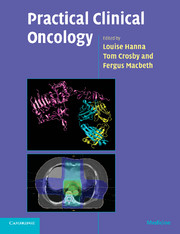Book contents
- Frontmatter
- Contents
- List of contributors
- Preface
- Acknowledgements
- Abbreviations
- 1 Practical issues in cytotoxic chemotherapy usage
- 2 Biological treatments in cancer
- 3 Hormones in cancer
- 4 Radiotherapy planning
- 5 Research in cancer
- 6 Oncological emergencies
- 7 Palliative care
- 8 Head and neck
- 9 Oesophagus
- 10 Stomach
- 11 Liver, gallbladder and biliary tract
- 12 Exocrine pancreas
- 13 Colon and rectum
- 14 Anus
- 15 Gastrointestinal stromal tumours
- 16 Breast
- 17 Kidney
- 18 Bladder
- 19 Prostate
- 20 Testis
- 21 Penis
- 22 Ovary
- 23 Body of the uterus
- 24 Cervix
- 25 Vagina
- 26 Vulva
- 27 Gestational trophoblast tumours
- 28 Lung
- 29 Mesothelioma
- 30 Soft tissue and bone tumours in adults
- 31 The lymphomas and myeloma
- 32 Central nervous system
- 33 Skin cancer other than melanoma
- 34 Melanoma
- 35 Thyroid
- 36 Neuroendocrine tumours
- 37 Cancer in children
- 38 Cancer of unknown primary
- 39 The use of radiotherapy in the treatment of benign conditions
- Multiple choice questions
- Multiple choice answers
- Index
- References
19 - Prostate
Published online by Cambridge University Press: 23 December 2009
- Frontmatter
- Contents
- List of contributors
- Preface
- Acknowledgements
- Abbreviations
- 1 Practical issues in cytotoxic chemotherapy usage
- 2 Biological treatments in cancer
- 3 Hormones in cancer
- 4 Radiotherapy planning
- 5 Research in cancer
- 6 Oncological emergencies
- 7 Palliative care
- 8 Head and neck
- 9 Oesophagus
- 10 Stomach
- 11 Liver, gallbladder and biliary tract
- 12 Exocrine pancreas
- 13 Colon and rectum
- 14 Anus
- 15 Gastrointestinal stromal tumours
- 16 Breast
- 17 Kidney
- 18 Bladder
- 19 Prostate
- 20 Testis
- 21 Penis
- 22 Ovary
- 23 Body of the uterus
- 24 Cervix
- 25 Vagina
- 26 Vulva
- 27 Gestational trophoblast tumours
- 28 Lung
- 29 Mesothelioma
- 30 Soft tissue and bone tumours in adults
- 31 The lymphomas and myeloma
- 32 Central nervous system
- 33 Skin cancer other than melanoma
- 34 Melanoma
- 35 Thyroid
- 36 Neuroendocrine tumours
- 37 Cancer in children
- 38 Cancer of unknown primary
- 39 The use of radiotherapy in the treatment of benign conditions
- Multiple choice questions
- Multiple choice answers
- Index
- References
Summary
Introduction
The biological behaviour of prostate cancer varies widely. Many tumours are found incidentally, whereas others cause signs and symptoms early on and may progress rapidly to disseminated disease. The incidence of disease is increasing, probably as a result of greater detection, but it is not clear whether earlier diagnosis will lead to longer survival. For men with early stage prostate cancer, the best treatment is not known and there are options of observation, surgery, external beam radiotherapy or brachytherapy. For patients with advanced disease, the main treatment is hormonal, in the form of androgen deprivation. Attempts are currently under way to improve the therapeutic ratio of radiotherapy by using new techniques such as intensity-modulated radiation therapy (IMRT).
Range of tumours
Types of tumours of the prostate are shown in Table 19.1.
Incidence and epidemiology
The incidence of prostate cancer in the UK is 87 in 100,000 per year; approximately 30,000 cases occur annually, with approximately 10,000 deaths in the UK. Prostate cancer is the second most common cause of cancer death in men. Disease incidence is increasing, which is attributed to increased disease screening. The peak incidence age is 70 to 75 years. The geographical distribution varies; the highest incidence occurs in Western countries and the lowest incidence is in Asia. Age-specific mortality rates have fallen slightly in both the USA and the UK, perhaps related to better treatment rather than screening because the UK has no organised screening programme.
- Type
- Chapter
- Information
- Practical Clinical Oncology , pp. 231 - 239Publisher: Cambridge University PressPrint publication year: 2008

